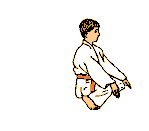Ukemi is one of the most controversial aspects of the martial arts. So many people think that ukemi is about falling down, how to fall down, about being thrown. Well, of course it is, but it is also about so much more. Ukemi, the art of falling, is an essential part of learning judo.
Ukemi comes from the root verb ukeru, “to receive.” Ukemi allows the attacker to safely receive the force of a throw or pin, absorbing the power of the technique while maintaining the intensity of the combative encounter. While it may seem that aggression and sensitivity are antithetical qualities, Judo balances the principles of martial effectiveness with a paradigm of harmony and non-aggression. So ukemi, the art of receiving, becomes a method of investigating the harmonious resolution of conflict, and a window into the subtle power of Judo.

Proper ukemi requires the development of several important principles. For instance, the attacker or uke learns how to keep a connection with the movements of tori. This connection allows uke to absorb a response to an attack safely, without harm. A connected attack becomes a primary method of technical transmission—uke feels the movement, and tries to duplicate the movement on his/her partner. Uke needs to improve external flexibility in order to gain this receptive awareness and maintain good connection. Ukemi does not simply involve compliance — students need to learn the proper use of power and resistance in their attacks.
Judo is a unique martial art, with ukemi skills more refined and subtle than in any other martial discipline (with the possible exception of Aikido). What makes ukemi so valuable is the fact that it teaches us how vulnerable we are when we attack someone. The role of uke is one of trust – the tori could kill you. No other martial art allows you to experience vulnerability to this extent and with this level of sensitivity and do not allow you to safely put as much power into a throw as we can in Judo.
By learning how vulnerable we are in conflict helps us discover the compassionate element of budo: how important it is to protect oneself and also the other person, whether it is an angry spouse or a threatening stranger. All life is sacred, and ukemi becomes a way to receive wisdom, a window into our interconnection and mutual vulnerability.
It is difficult to express in words the buzz of being on the receiving end of a well executed technique, and to be able to complement that technique with a well executed ukemi. Equally so, judo is probably at its most enjoyable when you can commit 100% into a technique and be safe in the knowledge that your uke will ukemi without injury.
The following are some points for good ukemi.
Form. Our Sensies teach us the basic form and shape of each ukemi. Depending upon your sex, height, weight and build only you can tweak the angles and round off the corners of your body entering and leaving ukemi until you are happy and comfortable. Feel the mat with all your body and listen to what it is telling you. Some may comment that you have an unorthodox fall, but if it works for you that’s OK. Also remember that while others will try to assist you with tips of their own, what works for them might not necessarily work for you.
Relaxation. No matter what type of ukemi you make, relax your body. The only strength in your body should be your unbendable spirit.
Never Hold Your Breathe. If you do not relax into your ukemi you will inevitably injure yourself. Breath out as you reach the ‘point of no turning back’ as you enter into ukemi, because you will naturally relax with your outward breath
Blend. Learn to blend with and not resist tori’s technique. Judo is about harmony, so harmonise with your training partner throughout practising the technique. Your partner will appreciate your co-operation because it helps him to perfect his/her technique, you will benefit because you will find ukemi easier to perform because you will be in the correct position to enter the fall, and thus not injure yourself. Resistance to a technique does not help you or your partner and will lead to your own injury. Physical resistance is generally exercised during randori to test your partner’s technique.
Spirit. It is a flow of energy that perpetually flows through and around our bodies, and when it can be harnessed and directed it is incredibly powerful. Try to imagine your ki flowing from your fingertips like water out of a fire hose as you make your forward rolling ukemi, it will help keep that smooth crescent shape and prevent you from bending your arm as you enter the ukemi.
Confidence. Confidence comes with repeated practice. As soon as you feel comfortable with a kneeling forward ukemi, progress to a standing ukemi and so on. One cannot land from kata garuma on the mat and expect to ukemi safely if you have just mastered a kneeling ukemi, because if you injure yourself it is not as simple as ‘getting back on that bicycle’ to try again.
Methods
Ukemi is one essential set of techniques that will prevent you from gaining unnecessary injury. To the more advanced, after learning the basics of the various break falling techniques you should continue to refine your skills and to practise them diligently. Unfortunately there's no substitute for mat time to develop ones ukemi.
First learn how to fall from a sitting position, then a squatting position, then progress to a standing position. But the most efficient way to develop a good break fall is by being thrown, you learn in a very unique way, the mechanics of the throws being used. The Novice is introduced to the unfamiliar feeling of movement in an upside down position, probably never encountered before.
To be able to advance in throwing techniques requires fluid movements and commitment, neither of which can be achieved by someone who is terrified of being thrown.
There are three methods of falling; these are first is to fall directly to the ground dissipating the forces through your arms and legs, the second to blend with the ground by rolling, and the final method is a combination of the other two methods.
The Dropping Method
Key points to remember when a Dropping technique of falling is used:
- Breathe naturally
- Relax and fall like a ‘baby or drunk’
- The fall is broken when one or both arms with open palms strike downward at the mat at 45° angles to the body. The feet also absorb the force when they strike the surface just before or at the same time as the arms.
- Forward break fall (dive)
- Backward break fall
- Side break fall
- Handstand break fall
The Rolling Method
The Rolling Breakfalls method is different to the Dropping Method of Breakfalls, because they do use the arms or legs to strike down to the mat or ground. The objective of the rolling break fall is to make your body round like a ball and by using the momentum to get back onto your feet.
- Shoulder roll
- Backward roll
- Sideward roll
- Cartwheel
The Combination Method
When the two other methods are combined, the theory between the two, allow you many techniques. The beauty of these combined techniques is that they omit the shock of the Dropping method enough to provide a smoother transition to the ground.
- Shoulder roll – Side break fall
- Shoulder roll – Handstand break fall
More advanced techniques of falling may include:
- To pick up a weapon / object while executing a fall.
- To break fall with a weapon. I.e. Sword, or Bo etc.
- Without using the hands
- Hand spring
- The Drunken forward roll
Conclusion
Good ukemi requires flexibility. During Vermont’s ice storm in 1998, young, pliant birch trees bowed to the ground while century old maples shattered under the weight of ice. Flexibility is our body’s ability to stretch, twist, or compress, and then conform once again. This is the same elastic energy that allows a ball to bounce (the bottom of the ball deforms and then pushes upward as it returns to its original shape). This resiliency allows us to imitate the falling cat, with its graceful, springy ability to land upright even when falling from awkward angles.
The more the body absorbs the force of the throw through flexion, the more uke feels a sense of identification and connection to the power of the throw.As a result, uke gains a better under- standing of how to access the power of a technique when taking the defensive role as tori. A simple experiment: Stand like a board, without flexing the back while falling. How does the fall feel? Note the throw is an all-or- nothing proposition: You either resist or crash to the floor. Then relax, put power in your abdominal region yet soften the muscles in the back and chest. How does this feel? When you allow your back to flex, there is more time to feel the force of the throw and to understand the source of that power. Back flexibility, then, is extremely important to receptivity.
This need for flexibility necessitates conditioning— judoka need to continually improve flexibility. There is a saying in hatha yoga that “you are only as old as your spine.” It is possible to increase flexibility as one grows older, but to do so requires patience and discipline. Work on your flexibility some – especially hamstrings, quadraceps, hips, and lower back. A lot of the energy from a fall is absorbed in the musculature, and a good uke relies on the muscles crossing his hips, knees, and lower back to control the direction and the impact of the fall. Just a little extra flexibility will do wonders.
Find a partner you trust. You are going to hurt each other, you need to both feel confident in the other. Work through some of the basic techniques with full commitment from both sides. Find out what works and what doesn't. Once you've experienced and understood a committed technique, bring that feeling into your training when techniques are being performed at a lower intensity.

Ukemi is about receiving the fall gracefully. In judo and life this is important so that you can rise up to continue the struggle. We learn that you can benefit from the lesson of the fall rather than suffer from it. Falling in judo teaches us to get to acceptance quickly. We must not deny that we were thrown, dwell on it, feel angry or depressed about it, or try to justify it. We must accept it as a lesson and move on before we are pinned where we lie.
Sure we try to avoid the setback, and we understand the potential danger of a fall, but we learn to accept it in a way that does not paralyze us. In fact it frees us to take risks and show more courage and commitment in our actions. It allows us to remain in control of our future and not give in to unfortunate circumstances.
In addition, it keeps us humble and grounded. A Turkish proverb says, "He who sleeps on the floor cannot fall out of bed."
